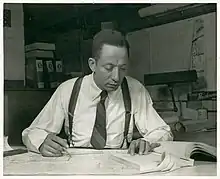Hilyard Robinson
Hilyard Robert Robinson (1899 – July 2, 1986), was a prominent African-American architect and engineer.
Hilyard Robinson | |
|---|---|
 Robinson working on plans and specifications for a new war-housing projects at Ypsilanti, Michigan | |
| Born | Hilyard Robert Robinson 1899 Washington, D.C., U.S. |
| Died | 29 June 1986 (aged 86–87) Washington, D.C., U.S. |
| Academic background | |
| Alma mater | University of Pennsylvania University of the Arts, Philadelphia Columbia University (GSAPP) |
| Academic work | |
| Institutions | Harvard University |
Biography
Hilyard Robinson was born in Washington, D.C., where his mother was a seamstress and his grandfather had a shoe-shining business. Robinson graduated from M Street High School and then studied at the Pennsylvania Museum and School of Industrial Arts (now University of the Arts, Philadelphia). During World War I Robinson served as a U.S. Army artillery officer where he spent time in Paris at the Armistice and observed the style of the buildings there. Upon his return to the United States, Robinson transferred to the University of Pennsylvania before eventually graduating from Columbia University in 1924 with a degree in architecture and working for several architectural firms and teaching at Howard University.[1]
In 1931, after he married Helena Rooks and completed a master's degree at Columbia, the Robinsons went to Europe to study in Germany, where Robinson was influenced by the Bauhaus style, as well as Scandinavia, France and elsewhere.
Robinson taught architecture at Howard University from the 1920s to 1960s, and he also designed many campus buildings.[2]
The U.S. Department of the Interior commissioned Robinson to build the Langston Terrace Dwellings (1935–1938) for which he gained prominence, and Robinson also served as an architectural consultant to the government of Liberia. Robinson worked closely with other American architects such as Ralph A. Vaughn and Paul Williams.[1][3] He had served as a mentor in 1945 to emerging architect Henry Clifford Boles.[4]
Robinson died in 1986 at Howard University Medical Center in Washington, D.C..
Notable works
- Aberdeen Gardens (Hampton, Virginia) (1934)
- Langston Terrace Dwellings (1935–1938)[2]
- Parkland Homes at Willow Run Bomber Plant (1943)
- Ralph Bunche House (Washington, D.C.) (1941)
- Sharpe Field Airport (1941)
- Arthur Capper/Carrollsburg (1958)
- Multiple Howard University buildings (Cramton Hall, the Ira Aldridge Theater, the School of Engineering, the Home Economics Building (now School of Human Ecology), Locke Hall)
References
- Amy DePaul, Historians' Projects To Honor Architect, Washington Post, October 16, 1986
- Bond, Max. "Still Here". Harvard Design Magazine, No. 2. Retrieved 2023-02-28.
- Ethridge, Harrison M. "The Black Architects of Washington, D.C., 1900-Present." Ph.D. diss., The Catholic University of America, 1979.
- Wilson, Dreck Spurlock (March 2004). African American Architects: A Biographical Dictionary, 1865-1945. Routledge. pp. 61–65. ISBN 978-1-135-95629-5.